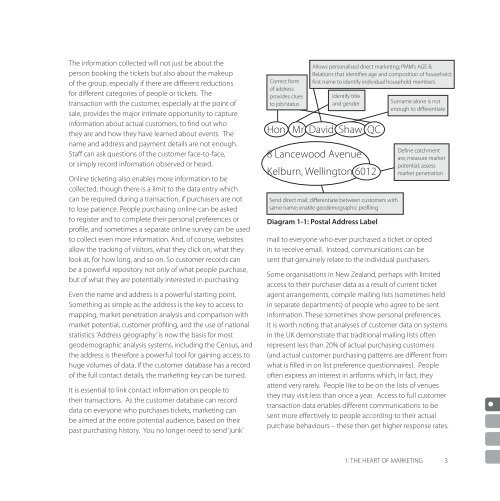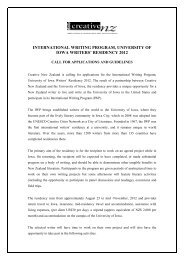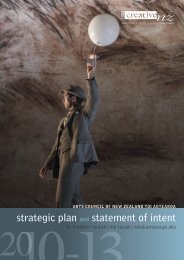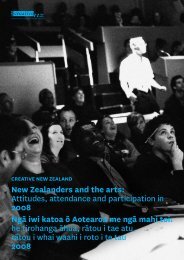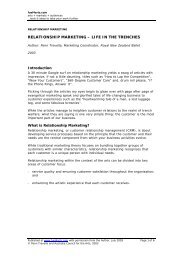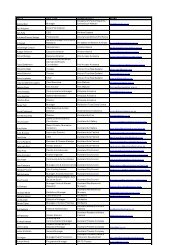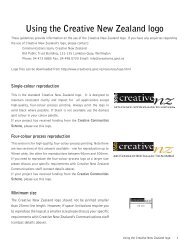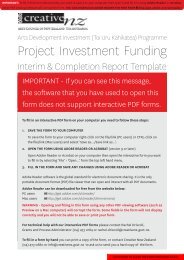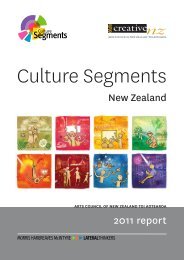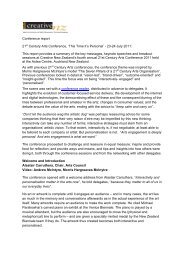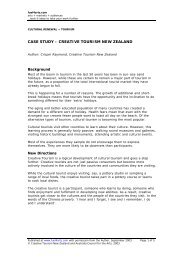FULL HOUSE Turning Data into Audiences - Creative New Zealand
FULL HOUSE Turning Data into Audiences - Creative New Zealand
FULL HOUSE Turning Data into Audiences - Creative New Zealand
Create successful ePaper yourself
Turn your PDF publications into a flip-book with our unique Google optimized e-Paper software.
The information collected will not just be about the<br />
person booking the tickets but also about the makeup<br />
of the group, especially if there are different reductions<br />
for different categories of people or tickets. The<br />
transaction with the customer, especially at the point of<br />
sale, provides the major intimate opportunity to capture<br />
information about actual customers, to find out who<br />
they are and how they have learned about events. The<br />
name and address and payment details are not enough.<br />
Staff can ask questions of the customer face-to-face,<br />
or simply record information observed or heard.<br />
Online ticketing also enables more information to be<br />
collected, though there is a limit to the data entry which<br />
can be required during a transaction, if purchasers are not<br />
to lose patience. People purchasing online can be asked<br />
to register and to complete their personal preferences or<br />
profile, and sometimes a separate online survey can be used<br />
to collect even more information. And, of course, websites<br />
allow the tracking of visitors, what they click on, what they<br />
look at, for how long, and so on. So customer records can<br />
be a powerful repository not only of what people purchase,<br />
but of what they are potentially interested in purchasing.<br />
Even the name and address is a powerful starting point.<br />
Something as simple as the address is the key to access to<br />
mapping, market penetration analysis and comparison with<br />
market potential, customer profiling, and the use of national<br />
statistics. ‘Address geography’ is now the basis for most<br />
geodemographic analysis systems, including the Census, and<br />
the address is therefore a powerful tool for gaining access to<br />
huge volumes of data. If the customer database has a record<br />
of the full contact details, the marketing key can be turned.<br />
It is essential to link contact information on people to<br />
their transactions. As the customer database can record<br />
data on everyone who purchases tickets, marketing can<br />
be aimed at the entire potential audience, based on their<br />
past purchasing history. You no longer need to send ‘junk’<br />
Correct form<br />
of address<br />
provides clues<br />
to job/status<br />
Allows personalised direct marketing; PMM’s AGE &<br />
Relations that identifies age and composition of household;<br />
first name to identify individual household members<br />
Identify title<br />
and gender<br />
Hon. Mr David Shaw QC<br />
8 Lancewood Avenue<br />
Kelburn, Wellington 6012<br />
Send direct mail; differentiate between customers with<br />
same name; enable geodemographic profiling<br />
Diagram 1-1: Postal Address Label<br />
Surname alone is not<br />
enough to differentiate<br />
Define catchment<br />
are; measure market<br />
potential; assess<br />
market penetration<br />
mail to everyone who ever purchased a ticket or opted<br />
in to receive email. Instead, communications can be<br />
sent that genuinely relate to the individual purchasers.<br />
Some organisations in <strong>New</strong> <strong>Zealand</strong>, perhaps with limited<br />
access to their purchaser data as a result of current ticket<br />
agent arrangements, compile mailing lists (sometimes held<br />
in separate departments) of people who agree to be sent<br />
information. These sometimes show personal preferences.<br />
It is worth noting that analyses of customer data on systems<br />
in the UK demonstrate that traditional mailing lists often<br />
represent less than 20% of actual purchasing customers<br />
(and actual customer purchasing patterns are different from<br />
what is filled in on list preference questionnaires). People<br />
often express an interest in artforms which, in fact, they<br />
attend very rarely. People like to be on the lists of venues<br />
they may visit less than once a year. Access to full customer<br />
transaction data enables different communications to be<br />
sent more effectively to people according to their actual<br />
purchase behaviours – these then get higher response rates.<br />
1: THE HEART OF MARKETING


